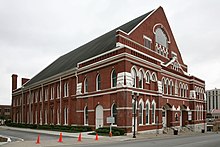Ryman Auditorium
| "The Mother Church of Country Music" "The Carnegie Hall of the South" "The Ryman" |
|

Ryman Auditorium, facing Nashville's Fifth Avenue North
|
|
| Former names | Union Gospel Tabernacle (1892–1904) Grand Ole Opry House (1963–1974) |
|---|---|
| Location | 116 Fifth Ave. N Nashville, Tennessee United States |
| Coordinates | 36°9′40.6″N 86°46′42.6″W / 36.161278°N 86.778500°W |
| Owner | Ryman Hospitality Properties, Inc. |
| Type |
Concert hall Theatre Broadcast venue |
| Seating type | Pews |
| Capacity | 2,362 (1994–present) |
| Construction | |
| Built | 1885–1892 |
| Opened | 1892 |
| Renovated | 1901, 1952, 1989, 1994 |
| Expanded | 1897, 1994, 2015 |
| Construction cost | US$100,000 (equivalent to $2,665,556 in 2016) |
| Website | |
| www |
|
|
Ryman Auditorium
|
|
| Location | 116 Fifth Ave. N Nashville, Tennessee |
|---|---|
| Coordinates | 36°9′40.6″N 86°46′42.6″W / 36.161278°N 86.778500°WCoordinates: 36°9′40.6″N 86°46′42.6″W / 36.161278°N 86.778500°W |
| Area | 1 acre (0.40 ha) |
| Built | 1891 |
| Architect | Hugh Cathcart Thompson |
| Restored | 1952, 1989, 1994 |
| NRHP Reference # | 71000819 |
| Significant dates | |
| Added to NRHP | May 6, 1971 |
| Designated NHL | January 3, 2001 |
Ryman Auditorium (formerly Grand Ole Opry House and Union Gospel Tabernacle) is a 2,362-seat live performance venue, located at 116 5th Avenue North, in Nashville, Tennessee and is best known as the home of the Grand Ole Opry from 1943 to 1974. It is owned and operated by Ryman Hospitality Properties, Inc.
Ryman Auditorium was included in the National Register of Historic Places in 1971, and was further designated a National Historic Landmark on June 25, 2001, for its pivotal role in the popularization of country music.
The auditorium opened as the Union Gospel Tabernacle in 1892. Its construction was spearheaded by Thomas Ryman (1843–1904), a Nashville businessman who owned several saloons and a fleet of riverboats. Ryman conceived of the auditorium as a for the influential revivalist Samuel Porter Jones. Ryman had attended one of Jones' 1885 tent revivals with the intent to heckle, but was instead converted into a devout Christian, and soon after pledged to build the tabernacle so the people of Nashville could attend a large-scale revival indoors. It took seven years to complete and cost US$100,000 (equivalent to $2,665,556 in 2016). However, Jones held his first revival at the site on May 25, 1890, with only the building's foundation and six-foot walls standing. Architect Hugh Cathcart Thompson designed the structure. Exceeding its construction budget, the tabernacle opened US$20,000 (equivalent to $533,111 in 2016) in debt. Jones sought to name the tabernacle in Ryman's honor, but Ryman denied the request several times. When Ryman died in 1904, his memorial service was held at the tabernacle. During the service, Jones proposed the building be renamed Ryman Auditorium, which was met with the overwhelming approval of the attendees. Jones died less than two years later, in 1906.
The building was originally designed to contain a balcony, but a lack of funds delayed its completion. The balcony was eventually built and opened in time for the 1897 gathering of the United Confederate Veterans, with funds provided by members of the group. As such, the balcony was named the Confederate Gallery. Upon the completion of the balcony, the Ryman's capacity rose to 6,000. A stage was added in 1901 that reduced the capacity to just over 3,000.
...
Wikipedia

